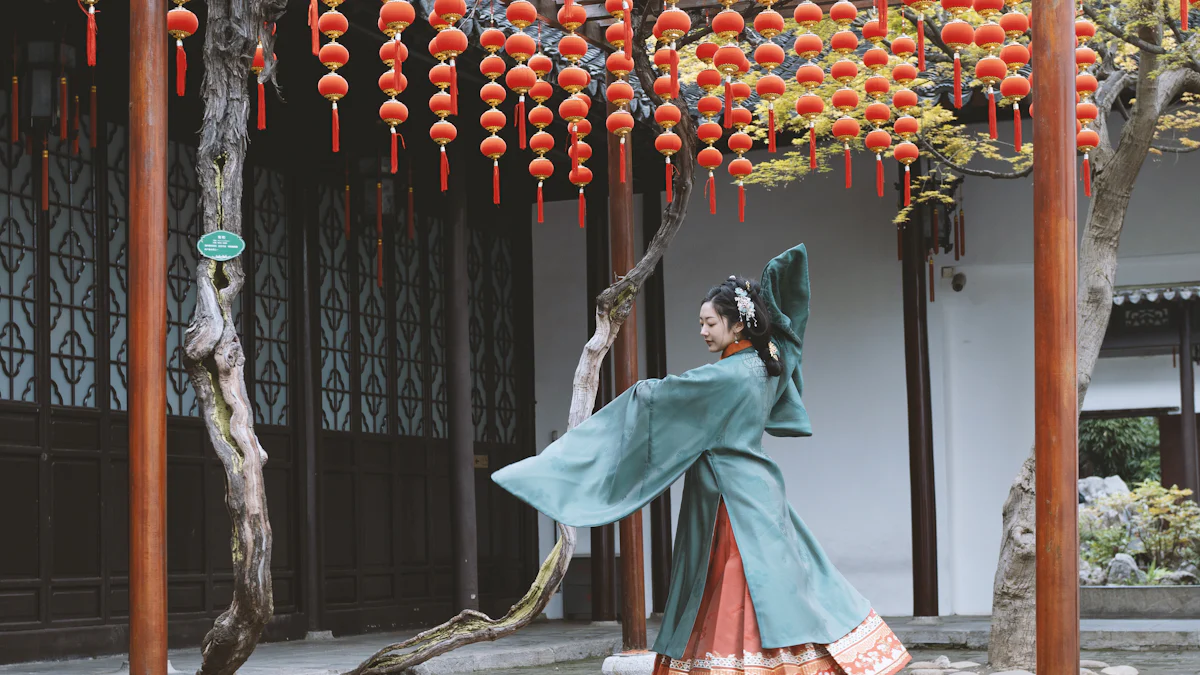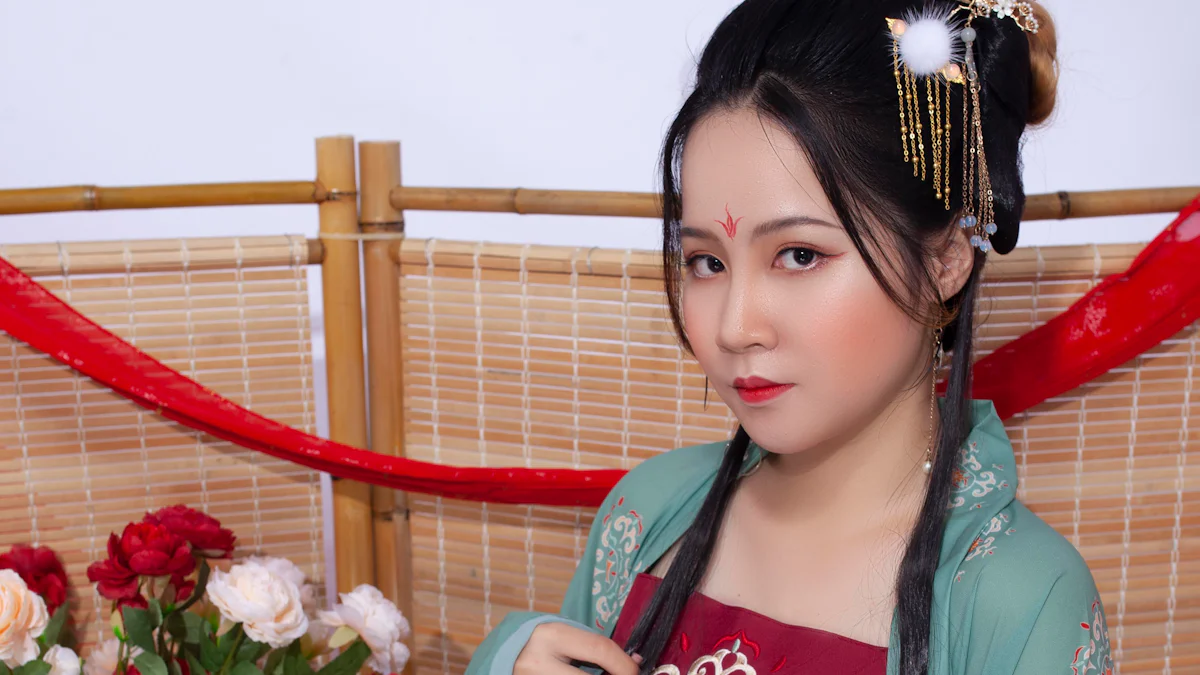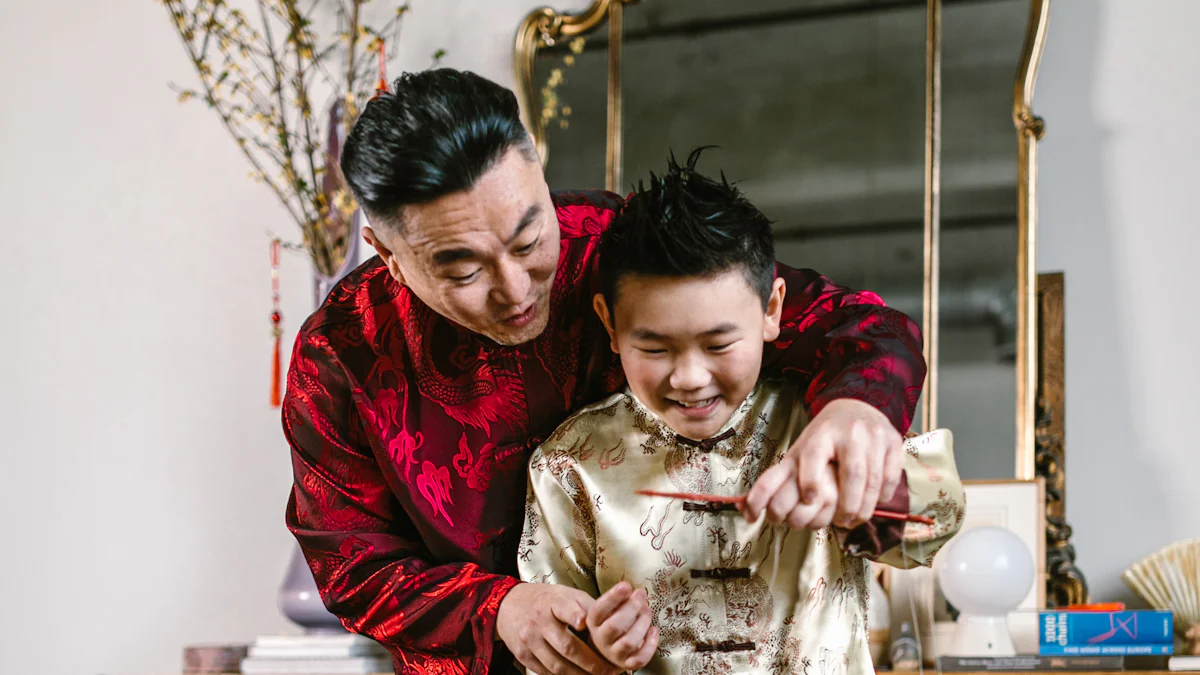Tang Suits: From Ancient Tradition to Modern Symbol

The Tang suit, also known as Tangzhuang, represents a significant aspect of Chinese culture. Originating from the Qing Dynasty, this traditional garment symbolizes elegance, craftsmanship, and cultural heritage. The Tang suit male version features distinctive elements like the mandarin collar and symbolic Chinese characters such as Fu (happiness) and Shou (longevity). Today, Tang suits gain popularity among young Chinese people and TV presenters, especially during Spring Festival Galas. Overseas Chinese also wear Tang suits during the Spring Festival, attracting foreigners and promoting Chinese culture globally.
Historical Origins of Tang Suits

The Tang Dynasty
Cultural and Political Context
The Tang Dynasty, spanning from 618 to 907 AD, marked a period of immense cultural and political prosperity in China. This era saw the flourishing of arts, literature, and trade. The Silk Road facilitated cultural exchanges between China and other civilizations. The Tang Dynasty's cosmopolitan nature influenced fashion trends, leading to the emergence of distinctive clothing styles.
Emergence of Tang Suits
The Tang suit emerged during the early Tang Dynasty as a symbol of elegance and status. Wide sleeves and a loose fit characterized this garment. The scholarly elite and nobility wore these robes, which vividly represented the wearer’s social standing. The Tang suit absorbed elements from both the Chinese heartlands and the diverse ethnic groups along the Silk Road. This cross-cultural influence enriched the design and significance of the Tang suit.
Early Characteristics
Design Elements
Early Tang suits featured several unique design elements. The mandarin collar became a prominent feature, symbolizing authority and sophistication. Intricate embroidery adorned the fabric, often depicting auspicious symbols such as dragons and phoenixes. These elements not only enhanced the garment's aesthetic appeal but also conveyed cultural and spiritual meanings.
Materials and Fabrics
Craftsmen used luxurious materials to create Tang suits. Silk, known for its softness and sheen, was the primary fabric. Artisans often dyed the silk in vibrant colors, reflecting the wearer's status and taste. Gold and silver threads were sometimes woven into the fabric, adding a touch of opulence. The use of high-quality materials and meticulous craftsmanship made Tang suits highly prized possessions.
"The Tang suit is a symbol of Chinese elegance, rooted in the rich history of China, symbolizing the timeless elegance of various Chinese dynasties."
The Tang suit's early characteristics laid the foundation for its enduring legacy. By threading cultural significance, craftsmanship, and tradition together, the Tang suit continues to reflect the social standing and authority of the wearer.
Evolution of Tang Suits Over Time
Changes in Design
Influence of Different Dynasties
Different Chinese dynasties influenced the design of Tang suits. The Song Dynasty introduced more fitted garments, contrasting with the loose-fitting robes of the Tang Dynasty. The Ming Dynasty added intricate embroidery and elaborate patterns. The Qing Dynasty incorporated elements from the Manchu 'Magua,' leading to the modern Tang suit's distinctive look.
Adaptations in Style
Tang suits adapted to modern aesthetics and practicality over time. Designers began using contemporary fabrics like cotton and synthetic blends. Modern Tang suits often feature simplified designs, making them suitable for everyday wear. These adaptations ensure the Tang suit remains relevant in today's fashion world.
Cultural Significance
Symbolism in Traditional Chinese Society
The Tang suit holds deep symbolism in traditional Chinese society. The mandarin collar represents authority and dignity. Embroidered symbols like dragons and phoenixes convey power and prosperity. The use of colors like red and gold signifies good fortune and happiness.
Role in Ceremonial Events
Tang suits play a significant role in ceremonial events. People wear Tang suits during festivals like the Spring Festival and Mid-Autumn Festival. The garment symbolizes cultural pride and heritage. Tang suits also appear in weddings and formal gatherings, reflecting the wearer's respect for tradition.
"The Tang suit continues to evolve and adapt to modern times, serving as a testament to the enduring legacy of Chinese fashion and its ability to transcend time and cultural boundaries."
The evolution of Tang suits showcases the blend of tradition and modernity. By adapting to changing times while retaining core elements, the Tang suit remains a symbol of Chinese cultural heritage.
Modern-Day Significance of Tang Suits

Revival in Contemporary Fashion
Influence on Modern Designers
Modern designers have embraced the Tang suit, integrating traditional elements with contemporary styles. The mandarin collar and knot buttons remain prominent features. Designers often incorporate these elements into modern jackets and dresses. This blend of old and new appeals to fashion enthusiasts worldwide.
The use of luxurious fabrics like silk and brocade continues. These materials add elegance and sophistication to modern designs. Embroidery techniques such as Xiang and Su enhance the aesthetic appeal. These techniques add intricate patterns and cultural symbols to the garments.
Popularity in Global Fashion
Tang suits have gained popularity in global fashion. Celebrities and influencers wear Tang suits at international events. This exposure increases interest in traditional Chinese clothing. Tang suits appear on runways and in fashion magazines. This visibility helps promote Chinese culture globally.
Chinese expats often wear Tang suits to celebrate their heritage. The garments serve as a bridge between Eastern and Western sartorial sensibilities. Tang suits also influence the traditional clothing of other East and Southeast Asian countries. Countries like Japan, Korea, and Vietnam incorporate similar elements into their attire.
Tang Suits in Modern Chinese Society
Use in Festivals and Celebrations
Tang suits play a significant role in modern Chinese festivals. People wear Tang suits during the Spring Festival and Mid-Autumn Festival. These garments symbolize cultural pride and tradition. The vibrant colors and intricate designs add to the festive atmosphere.
Weddings and formal gatherings often feature Tang suits. The attire reflects respect for tradition and cultural heritage. The use of auspicious symbols like Fu (happiness) and Shou (longevity) adds a layer of meaning. These symbols convey good fortune and best wishes.
Symbol of Cultural Identity
Tang suits serve as a symbol of cultural identity. The garments represent a connection to Chinese history and tradition. Wearing a Tang suit signifies pride in one's heritage. The attire also fosters a sense of unity among Chinese people.
The versatility of Tang suits makes them suitable for various occasions. People wear them for both formal and casual events. The adaptability of the Tang suit ensures its continued relevance in modern society.
"The Tang suit continues to evolve and adapt to modern times, serving as a testament to the enduring legacy of Chinese fashion and its ability to transcend time and cultural boundaries."
The modern significance of Tang suits lies in their ability to blend tradition with contemporary fashion. By maintaining core elements while adapting to modern tastes, Tang suits remain a vital part of Chinese cultural heritage.
Practical Advice on Wearing Tang Suits
Choosing the Right Tang Suit
Factors to Consider
Selecting a Tang suit involves several considerations. Fabric choice plays a crucial role. Silk offers a luxurious feel and sheen, while cotton provides comfort and breathability. The occasion also dictates the fabric choice. Formal events often call for silk, whereas casual gatherings may suit cotton.
Fit is another important factor. Traditional Tang suits feature a loose fit, but modern adaptations offer more tailored options. Ensure the suit fits well across the shoulders and chest. The length of the sleeves and hem should complement the wearer's body type.
Color and design elements also matter. Traditional colors like red and gold symbolize good fortune and happiness. Embroidery featuring dragons, phoenixes, or Chinese characters like Fu (happiness) and Shou (longevity) adds cultural significance.
Where to Buy
Several options exist for purchasing Tang suits. Specialty stores in Chinatown districts often carry a variety of styles and fabrics. Online retailers like East Meets Dress offer custom options, allowing buyers to select fabrics and designs that match their preferences.
Local tailors can also create bespoke Tang suits. Custom tailoring ensures a perfect fit and allows for personalized design elements. Many tailors offer a range of brocade options and can match the fabric of the suit to other traditional garments like the cheongsam.
Styling Tips
Pairing with Accessories
Accessories enhance the overall look of a Tang suit. Traditional footwear like cloth shoes or embroidered slippers complements the attire. For a modern twist, loafers or dress shoes work well.
Jewelry adds an extra layer of sophistication. Jade pendants or bracelets provide a touch of traditional elegance. Brooches featuring auspicious symbols can be pinned to the suit for added flair.
Headwear also plays a role. Men can opt for traditional caps, while women might choose hairpins or combs adorned with intricate designs. These accessories not only complete the look but also add cultural depth.
Modern Adaptations
Modern adaptations of Tang suits make them versatile for various occasions. Pairing a Tang jacket with jeans creates a casual yet stylish outfit. Women can wear Tang blouses with skirts or trousers for a contemporary look.
Layering offers another way to modernize the Tang suit. A Tang jacket over a turtleneck or a dress shirt adds a fashionable twist. Mixing traditional elements with modern pieces allows for a unique and personalized style.
Incorporating Tang suits into everyday wear helps preserve cultural heritage while embracing modern fashion trends. The versatility of the Tang suit ensures its continued relevance in contemporary wardrobes.
Tang Suit Male
Tang Suit Male in Historical Context
Traditional Male Attire
Traditional male attire in ancient China featured distinct elements. The Tang suit male version emerged during the Qing Dynasty. This garment incorporated influences from the Manchu 'Magua.' The design included a mandarin collar and knot buttons. These features symbolized authority and sophistication.
The Tang suit male version often used luxurious materials. Silk was the primary fabric, known for its softness and sheen. Craftsmen dyed the silk in vibrant colors. Gold and silver threads added opulence. Intricate embroidery depicted auspicious symbols like dragons and phoenixes. These elements enhanced the garment's aesthetic appeal and cultural significance.
Evolution Over Time
The Tang suit male version evolved over different periods. Each dynasty influenced the design. The Song Dynasty introduced more fitted garments. The Ming Dynasty added elaborate patterns and embroidery. The Qing Dynasty incorporated elements from the Manchu 'Magua.' These changes reflected cultural, social, and political shifts.
Modern adaptations of the Tang suit male version have emerged. Designers use contemporary fabrics like cotton and synthetic blends. Simplified designs make the garment suitable for everyday wear. These adaptations ensure the Tang suit male version remains relevant in today's fashion world.
Tang Suit Male in Modern Fashion
Contemporary Designs
Contemporary designs of the Tang suit male version blend tradition with modernity. Designers integrate traditional elements like the mandarin collar and knot buttons into modern jackets. Luxurious fabrics like silk and brocade continue to be popular. Embroidery techniques such as Xiang and Su add intricate patterns and cultural symbols.
Modern designers often incorporate personalized elements. Custom tailoring allows for unique designs. Buyers can select fabrics and embroidery that match their preferences. This personalization enhances the garment's appeal and cultural significance.
Popularity Among Men
The Tang suit male version has gained popularity among men. Celebrities and influencers wear Tang suits at international events. This exposure increases interest in traditional Chinese clothing. Tang suits appear on runways and in fashion magazines. This visibility helps promote Chinese culture globally.
Chinese expats often wear Tang suits to celebrate their heritage. The garments serve as a bridge between Eastern and Western sartorial sensibilities. Tang suits also influence the traditional clothing of other East and Southeast Asian countries. Countries like Japan, Korea, and Vietnam incorporate similar elements into their attire.
"The Tang suit male version continues to evolve and adapt to modern times, serving as a testament to the enduring legacy of Chinese fashion and its ability to transcend time and cultural boundaries."
The modern significance of the Tang suit male version lies in its ability to blend tradition with contemporary fashion. By maintaining core elements while adapting to modern tastes, the Tang suit male version remains a vital part of Chinese cultural heritage.
The Tang suit embodies both historical and modern significance. Originating from the Qing Dynasty, it symbolizes Chinese elegance and cultural heritage. The garment's intricate design elements and luxurious materials reflect its rich history.
The enduring legacy of the Tang suit in Chinese culture remains evident. It serves as a vibrant testament to China’s extensive history, showcased during significant events like the Lunar New Year and Mid-Autumn Festival. The Tang suit represents a cultural legacy passed down through generations.
The future of Tang suits in global fashion looks promising. The garment continues to evolve, gaining popularity both in China and abroad. By embracing its rich history and contemporary innovations, the Tang suit has become a symbol of Chinese cultural heritage and a trendsetting icon in the world of fashion.

